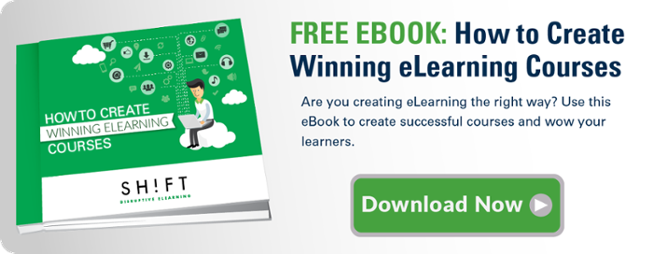 eLearning didn't happen overnight. It's a product of years of human ingenuity and innovation. There are moments in history that contribute to the inevitable birth of eLearning. So in an effort to weave a story of how eLearning came to be, here are some bits of history worth recalling.
eLearning didn't happen overnight. It's a product of years of human ingenuity and innovation. There are moments in history that contribute to the inevitable birth of eLearning. So in an effort to weave a story of how eLearning came to be, here are some bits of history worth recalling.
1. Early 1980s: The Introduction of Personal Computers
The early prototypes were, of course, crude versions of our current personal computers. Those were all read-only technologies, Web 1.0 as people call it. A major breakthrough took place in 1984 when Apple's Macintosh computer was introduced. It was first to offer better graphical and text support. Its unique mouse input also revolutioned how users interact with the machine.
The Macintosh, with its free HyperCard program, also helped a generation of tech-savvy teachers make their own software and tutorials for students. Commercial software companies were quick to develop computer-based educational materials and learning games as well.
2. 1990: The Development of Multimedia PC
The Multimedia PC (MPC) came with a CD-ROM drive, meaning that the device can display video synced with audio. Alongside CD-ROMs came Microsoft Powerpoint, a modern presentation software quickly embraced by lecturers, executives, teachers and students.
It's important to note how the MPC relaxed the learning barrier for students. Using a multimedia computer, they were able to utilize video, audio, graphics and animation programs so that they can better interact with the computer's interface.
It was also during the early 90s that many schools that deliver online-only courses were established. The future of the Internet as an education medium became certain.
3. 1999: The Word eLearning was Born
In November 1999, Elliott Masie coined the word "eLearning" at his TechLearn Conference at Disneyworld. It was the first time that the term was used in a professional context. Others in the industry have already used the term "online learning," which basically points to the same concept.
The term has always been used to refer to learning using the web or any other electronic medium. Professionals consider it as a type of distance learning since students are able to access materials and complete learning tasks even outside the classroom.
4. Early 2000s: The Dot Com Boom
The World Wide Web became mainstream, thanks to investors throwing money at anything web-related between1995 and 2000. CD-ROMs quickly became a thing of the past.
During this time, a number of sophisticated technologies significantly boost the progress of eLearning. Here are some of them:
- Increased bandwidth for faster and much improved multimedia content.
- High-speed Internet technologies including broadband and wireless LANs for faster connections.
- Bluetooth for short-range connectivity to devices such as phones and printers improved browser technologies for better user experience.
All of these made it possible for organizations to train employees using eLearning. Individuals eager to expand their skill sets and widen their knowledge base also turned to the Internet online degrees and free educational programs.
5. 2004: The Ascendancy of Web 2.0
Yes, the Web 2.0 as we all know it was introduced only a decade ago. The term was first coined by Darcy DiNucci in 1999 in her article "Fragmented Future." But it wasn't until 2004 that the term took wing when pen-source advocate Tim O'Reilly promoted the idea at the O'Reilly Media Conference.
From the read-only environment of Web 1.0, Web 2.0 promises a two-way conversation where users can contribute, collaborate and create through several platforms like social media, blogs, wikis and forums. Web 2.0 emphasizes on how we learn—how we interact with content online.
6. 2005: The Rise of Flash Video
In 2005, Adobe bought Macromedia and transformed it into Adobe Flash. It took of way too quickly, like a rocket. Developers who worked with it discovered just how flexible Flash is.
Flash didn't require a lot of bandwidth as older methods would have used. So it enabled users to embed and play back video easier and faster than before. Flash became an animation and authoring tool overnight, a tool so crucial at creating multimedia content.
The same year brought us YouTube, arguably the world's most visited site for uploading or watching videos online.
7. 2008: The Beginning of the Mobile Web
The mobile web started just a few years ago. Smartphones were introduced, Internet-enabled tablets came next, and you probably have witnessed the rest of the story. People in the office or at school has to have a mobile device. We modern-day, tech-savvy users expect that from everyone.
It's worth noting how Apple's iPod Touch, iPhone and iPad lines helped transform the way developers create educational software, the way teachers teach and the way students learn.
The era of the mobile web has not ended yet. It's only just begun. Experts suggest that mobile-enabled Internet access will eventually overtake desktop access by 2015.
9. 2010: The Reign of HTML5
No other emerging technology has changed the way we interact with content online than HTML5. This latest evolution of HTML, supplemented by CSS3 and JavaScipt, opened up a host of game-changing features:
- Compatibility with modern devices and browsers means wider user reach and device-agnostic eLearning content.
- Ability to detect device means content tailored to fit a learner's preferred device.
- Ability to embed a rich media experience makes it a viable alternative to Flash, which not all mobile devices support.
10) 2013: The Introduction of Tin Can API
Released on April 26, 2013, Tin Can API is the lastest version of SCORM tasked to solve many issues that plague the older versions.
Since it's ready for adoption, eLearning experts highly recommend Tin Can API to accomplish the following:
- Removal of the need for a browser
- Mobile learning
- team-based learning
- cross-domain functionality
- simulations or serious games




